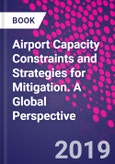When predicting the future of air traffic development, it is imperative for researchers and planners tohave the most accurate information about airport capacity constraints. Airport capacity constraintsand strategies for mitigation: A global perspective analyses airport capacity constraints with empiricalmethods that forecast future capacities and capacity shortfalls.The book discusses in detail the importance of airport capacity constraints on air traffic development,especially for international hubs, along with mitigation strategies for already congested airports. It analysesempirical data to provide greater insight into the problems of airport congestion and capacity shortage.The authors present detailed global traffic forecasts for the years 2030 and 2040, and mitigation strategiesfor overcoming the problem of limited airport capacity.As expanding current airports becomes increasingly difficult, and time consuming - especially for hubs- the study of current and future airport capacity constraints becomes ever more needed. This bookprovides detailed information about how to correctly assess and quantify the problem of limited airportcapacity, while offering strategies for overcoming these issues for a healthy global air traffic network.
Please Note: This is an On Demand product, delivery may take up to 11 working days after payment has been received.
Table of Contents
Part I: Basic concepts1. Introduction2. Concepts of capacity and methods of estimation3. Capacity utilisation at airports worldwide4. Constrained and underutilised airports
Part II: Models for assessing mitigation strategies5. General strategies for mitigation of airport capacity constraints6. Modelling future air passenger demand7. Modelling future airport capacity and capacity utilisation8. Modelling future airport capacity enlargements and limits9. Modelling future development of the average number of passengers per flight
Part III: Forecasting future air traffic development up to 2040 and assessing mitigation strategies10. Traffic forecast and mitigation strategies11. Summary and conclusions








